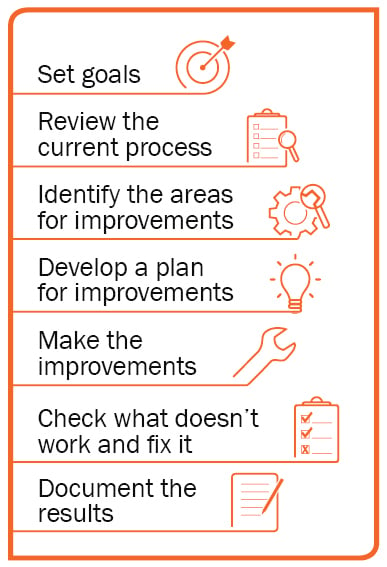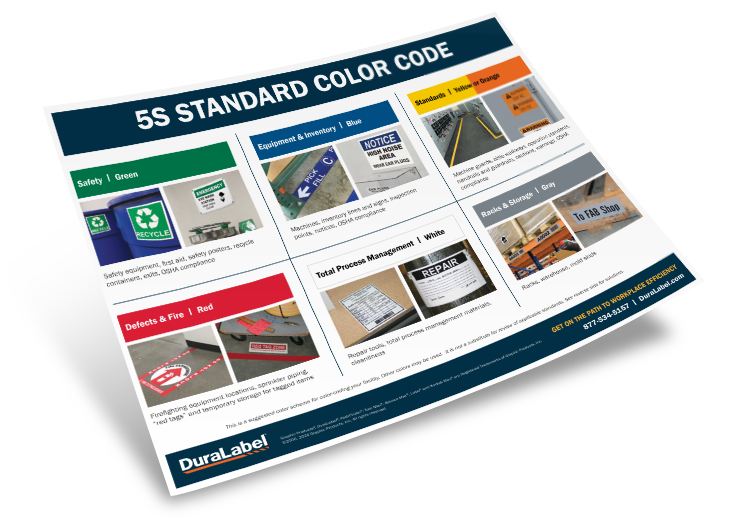Using Lean and Kaizen Theory in Manufacturing

How Kaizen and Lean Work Together to Improve Manufacturing
Incorporating Kaizen in manufacturing means combining continuous improvement with the structure of Lean thinking. Lean Kaizen implementation empowers frontline workers to suggest changes that reduce waste, improve processes, and optimize operations. When done right, manufacturing process improvement with Kaizen becomes part of the culture—driving efficiency from the ground up.
What is Lean Kaizen?
From the corner office to the production floor, Kaizen requires all employees to be involved in making improvements to their company. No single change drastically improves production on its own; instead, Kaizen is successful because it focuses on continuously making small changes that benefit the company over time by reducing waste and increasing profit.
To implement Kaizen Theory in manufacturing, a company must first recognize the need for change and then challenge the status quo by continuously improving upon the current situation.
Getting Started with Kaizen Theory
Kaizen's strength comes from recognizing that the people performing a task know the most about the task and how it can be improved. As such, Kaizen requires a system that encourages all employees to look for areas that can be improved upon and to suggest possible improvements. This is especially beneficial in a manufacturing environment, because the processes are repetitive and workers on the shop floor are especially aware of areas that need improvement.
Common methods for encouraging employee feedback include regular meetings and suggestion boxes. Each method is designed to create open and positive dialogue throughout the workplace.
Meetings: Regular meetings are ideal for gathering as many ideas for improvements as possible. They are also a great way to make sure everybody understands the purpose of Kaizen and its positive impact on the workplace. Let everybody know that there will be no punishments for making suggestions, and that employees will be rewarded for ideas that lead to improvements.
Suggestion boxes: Make sure that employees continue to provide ideas for improvements by using suggestion boxes. Ideally, the suggestions should list the date, name of employee (optional), problem, and possible solution. While some employees may not feel comfortable providing their name with their suggestions, it is a way to make sure employees are rewarded for their efforts. Over time, this shows employees that their ideas are valuable and encourages continued feedback.
What if employees don't provide feedback?
Sometimes giving broad instructions can be daunting to employees and make them less likely to respond. Instead, start with a goal, like reducing waste on the production floor, and ask for specific ways to work toward that goal:
- How can we eliminate overproduction?
- How can we improve manufacturing quality?
- How can we make manufacturing more efficient?
- How can we remove unneeded steps in manufacturing?
- How can we eliminate errors in the final product?
Any improvement that reduces waste will help increase efficiency and long-term profit.
Making Kaizen Stick
Now that you have ideas for improvements throughout your company, what's next? Build employee confidence in the Kaizen process by making them aware of the resulting changes and involving them in making the changes they suggest.
Act on good ideas: Finding and solving issues can be a cumbersome process in a manufacturing environment, because manufacturing processes are often created by people who do not work on the production floor. One way to ensure good ideas are acted upon is to create cross-functional teams that have the authority to challenge the status quo and act on ideas that improve the company.
Once employees realize that their ideas are valued, Kaizen is on its way to becoming part of the company's culture: employees, at all levels, are invested in improving the company.
Show employees trust: Another way to help Kaizen succeed in a manufacturing environment is to show workers that they are trusted. Toyota does this by allowing employees use the pull system and stop production in areas to avoid overproduction (waste). Toyota also allows many of their employees to implement their own ideas once they are approved.
Acting on good ideas and showing employees trust will help Kaizen become part of your company's culture.
Kaizen Events
In addition to small, continuous changes, Kaizen can be used to improve specific areas within the company by using a Kaizen Event. Kaizen Events are large-scale activities meant to create noticeable changes over a short period of time in specific areas. One Event could focus on redesigning the assembly line while another could focus on reducing cycle time.

An Event requires a specific team, including department heads and individuals from the production floor whose work is impacted by the change. In general, the team needs to do the following when setting up a Kaizen Event:
- Set goals
- Review the current processes
- Identify areas for improvements
- Develop a plan for improvements
- Make the improvements
- Check what doesn't work and fix it
- Document the results
Manufacturing is a complex process, and it is essential to involve each department in the Kaizen Event. An Event that impacts production, procurement, and shipping will not be as effective if any one department is left out. For example, improving production and shipping times while procurement stays the same may create a bottleneck that significantly slows down production until the issue is fixed.
Using Kaizen Events in addition to the small, continuous changes will create tangible results that allow employees, at all levels, to quickly see the value of adopting Kaizen as part of the workplace. Active practice of Kaizen will lead to continuous improvements in production, efficiency, and cost reduction.
How can DuraLabel Help with Kaizen Theory?
Need more information about Lean Kaizen Theory and how to implement it in your workplace? DuraLabel offers an in-depth Kaizen & PDCA Best Practice Guide to help make Kaizen a success.
Proper labeling and signage plays an important role in Kaizen by increasing productivity while reducing waste. Clear signage can make workers aware of changes to workflow, increasing efficiency; meanwhile, properly labeling hazards can lead to fewer injuries, decreasing the downtime and cost (waste) caused by workplace accidents.
Take Action Today
DuraLabel® Industrial Sign and Label Systems can help develop clear, custom visual communication. With a variety of printers and more than 50 specialty supplies, you'll find the right tools for your needs.
Looking to get started with Kaizen in manufacturing? Call us at 1-888-789-4303 to learn how DuraLabel can support your Lean Kaizen implementation with effective labeling and signage systems.
Related Resources
Logistics Tracking
Logistics involves managing the movement of resources. This not only includes products, but the movement and ...
Read
Quick Response Manufacturing
If you are familiar with lean manufacturing principles, you know that lean manufacturing is about eliminating ...
Read
What Is Kanban?
In the face of declining sales and profits during the 1950s, Eiji Toyoda began looking for ways to improve ...
Read.png)





